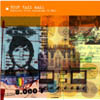 A series of crisply recorded audio snapshots from producer Tucker Martine's travels through the West African countryside in the fall of 1998, Bush Taxi Mali is probably the most disarmingly beautiful of the five new entries to the Sublime Frequencies discography. Capturing singers and instrumentalists in several small villages in the heart of Mali, Martine's impressive recordings recreate a rich, brilliantly rendered portrait of the Mande and Dogon people comprised of guileless performances from guitar and Fulani flute players, choruses of children and stunning vocal performances.Sublime Frequencies
A series of crisply recorded audio snapshots from producer Tucker Martine's travels through the West African countryside in the fall of 1998, Bush Taxi Mali is probably the most disarmingly beautiful of the five new entries to the Sublime Frequencies discography. Capturing singers and instrumentalists in several small villages in the heart of Mali, Martine's impressive recordings recreate a rich, brilliantly rendered portrait of the Mande and Dogon people comprised of guileless performances from guitar and Fulani flute players, choruses of children and stunning vocal performances.Sublime Frequencies
Interspersed are sounds captured from Bamako radio broadcasts, outdoor markets, street sounds, Bambaran wedding celebrations and the sounds of a village going to sleep under a clear night sky. In short, Martine provides a richly abstract documentary of his journey through these enchantingly exotic lands, through musical traditions at once foreign and hauntingly familiar to Western ears. On many vocal tracks, the blues-tinged accompaniment is performed on an instrument called the ngoni, the African ancestor of the banjo, made from fishing wires stretched over a drum body. On "Fouta Djallon," Martine captures a performance on the Fulani flute with accompanying drums, a hypnotic performance that resembles an uncomplicated version of the Moroccan pan pipes of Jajouka. Several tracks capture the beautiful vocal dynamics of female singer Jalimusa Amanita Diabate, from the prominent Diabate family of Malian musicians. Her vocal performances are singularly sad and pregnant with emotion, gloriously unsophisticated but remarkably articulate. On "Rihlah," she leans against the stone gateway to the village of Kela and effortlessly belts out a vocal lament that weaves a countermelody to the skillfully played ngonis. "O Mansa Musa" captures Sidiki Kouyate, playing an exquisite solo on acoustic guitar, a complex tune that draws a straight line from Mali's traditional musical heritage to the African-American folk and blues of the early 20th century.
Read More

